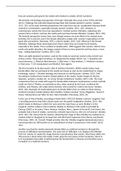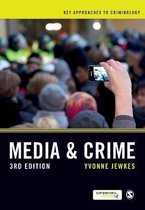How are women portrayed in the media with relation to Jewkes (2015) narratives
The feminist criminological perspective of female criminality first arose in the 1970’s with the
aim to ‘challenge the culturally biased perspectives that already existed in society’ (Jewkes,
2011: 125). In the early feminist perspectives the main focus was on ‘socialization theories which
centred on victimization, especially towards women’ (Jewkes, 2015: 125). However, in
contemporary society the focus has expanded to ‘include women offenders, explaining why
women fail to conform and how the media portrays these female offenders’ (Jewkes, 2015: 125).
The feminist perspective shows how, even though women are more likely to be treated more
leniently, this is only the case if the female offenders comply with ‘society’s expectations of the
good wife and mother’ (Kennedy, 1995: x cited in Jewkes, 2015: 126). Whereas if the female
offenders challenge these stereotypes then that is when they are treated more harshly,
especially in the media. This is evident as Hesidensohn, 1985 suggests that women ‘attract more
media and public attention, the image created of them is more powerful and they leave a more
long – lasting impression’ (Jewkes, 2015: 126).
There are eight standard narratives ‘used by the media to construct women who commit very
serious crimes. These eight narratives, as categorized by Jewkes (2011), are: 1. Sexuality and
sexual deviance, 2. Physical attractiveness, 3. Bad wives, 4. Bad mothers, 5. Mythical monsters,
6. Mad cows, 7. Evil manipulators and finally 8. Non-agents.
The first narrative to be discussed is that of mythical monsters. Within society today many
female killers that are portrayed in the media are known as and can be related back to ‘pagan
mythology, Judaeo - Christian theology and classical art and literature’ (Jewkes, 2015: 146).
According to Jewkes these modern interpretations in the media ‘invoke images of witches,
Satanists, vampires, harpies etc. to convey female wickedness’ (Jewkes, 2015: 146). The main
comparisons that are made with regard to female killers between contemporary society and folk
myths are that of ‘Medea, an enchantress who, when spurred by her lover, murdered her
children, and Medusa, the snake haired monster who turned her victims into stone’ (Jewkes,
2015: 146). Examples of media labels given to female killers that can relate to these famous
mythical monsters include Medusa Myra Hindley, ‘lesbian vampire’ Tracey Wigginton, ‘beast of
Noosa’ Valmae Beck and ‘killer for love’ Karla Homolka’ (Morrissey, 2003: 24).
In the case of Myra Hindley, according to Helen Birth (1993:33) Hindley’s famous ‘mugshot’ had
a ‘brooding presence that held a bizarre grip over the public imagination (Jewkes, 2011: 146)
which relates to Medusa in which her eyes were the main focus as were Hindley’s in the
mugshot. Further evidence that combines Hindley to Medusa in the media is provided by
Glancey (2002) as he states ‘Myra, Medusa. Medusa, Myra…Spawn of the devil, God knows, she
probably had a head of snakes, covered by a blonde wig to fool us, this evil, evil woman’ (Jewkes,
2011: 146). This shows that the media is distorting the image of Myra Hindley by relating her to
medusa which is ‘designed to increase fear and elicit harsh responses from the lay community’
(Morrissey, 2003: 25). Overall, Wright provides that the ‘Hindley mugshot demonstrates how a
normal portrait can still function as an embodiment of what is monstrous in the media’ (2013:
144).
Another way that the media represents female killers as mythical monsters is through the
process of vilification/monsterization. The main aim of vilification is to ‘displace the offender
from her society, to create the image that she is produced by that society’ (Morrissey, 2003: 24).
This process is done where the media ‘insists upon the evil nature of the murderess’ which in
turn manipulates the public to believing that the female killer is inhuman and therefore just a
recreation of a mythical monsters.





